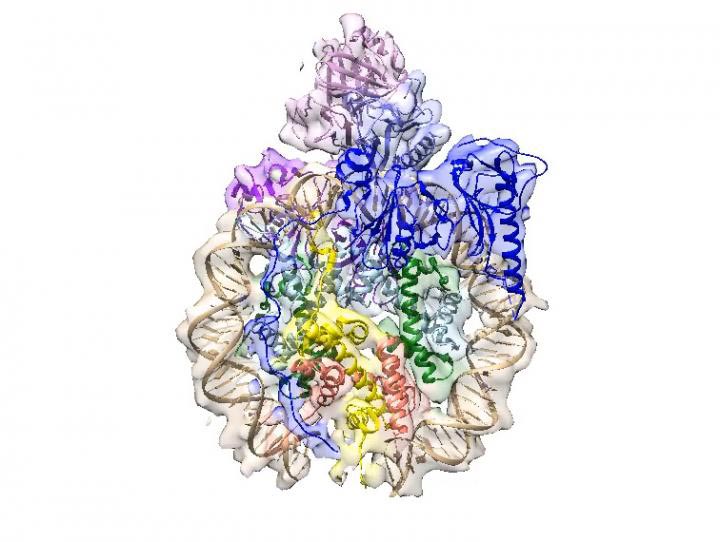Scientists now know what DNA's chaperone looks like

A visualization of the FACT protein. Credit: Liu et al. 2019
A team of researchers at the University of Colorado Boulder has cracked the puzzle of the Facilitates Chromatin Transcription (FACT) protein structure. This protein is partly responsible for making sure everything goes smoothly and no improper interactions take place when DNA temporarily sheds and replaces its guardian proteins, or histones.
These findings, which are the result of a project five years in the making at CU Boulder and out today in the journal Nature, will have ripple effects for not only our understanding of the genome and gene transcription, but for our understanding of cancer and the development of anti-cancer drugs.
“This is just the start for this protein. It's not the end,” said Yang Liu, a research associate in the Department of Biochemistry at CU Boulder and one of the study's lead authors.
Ever since its discovery in 1998, the FACT protein has been of great interest for those who study DNA, largely because of the possibilities it presents. But, despite decades of effort, many of the central questions of how the protein works remain unanswered.
The FACT protein is an essential type of histone chaperone. These guardian proteins escort other proteins during the deconstruction and reconstruction of nucleosomes, or the structural unit responsible for organizing and packaging DNA. This happens during gene transcription (the step where DNA is copied into RNA), DNA replication (where the entire genome is replicated faithfully) and DNA damage repair (which is essential to prevent disease such as cancer).
However, with no clear structure for the protein available, scientists have been less than clear as to how exactly it does both: How does one protein both destroy and maintain?
This new research sheds light on both.
“For a long time, people have been trying to find the mechanism behind how [this protein] helps transcription,” said Keda Zhou, a research associate in biochemistry at CU Boulder and the other lead author for the paper. “People have been working on different aspects of this protein, so we're really happy that we're the first to see it in action. It's really exciting.”
The research team, aided by two other labs also led by women also managed to finally solve the puzzle by isolating the FACT protein and, through a combination of hard-work, ingenuity and tenacity, map it out and catch it in the act of both destroying and maintaining the nucleosome.
What they found is that FACT resembles the saddle and fork of a unicycle, made up of multiple domains that straddle the nucleosome 'wheel' of the unicycle. Up until that point, researchers were seeing only one domain at a time, causing confusion and contradictory results.
And yet, it appears that none of those differing findings are wrong.
Liu and Zhou's work “really put everything together. And it seems like everybody's right, which is just really cool,” said Karolin Luger, the endowed chair of biochemistry at CU Boulder, a Howard Hughes Medical Institute Investigator and the study's senior author.
This discovery is only the beginning for this protein, both for Luger's lab and the broader medical community.
“There are lots of unknowns,” said Zhou. “But this is a starting point.”
###
Other coauthors on the new study include researchers at the University of Texas at Dallas, National Resource for Automated Molecular Microscopy and Columbia University.
Media Contact
All latest news from the category: Life Sciences and Chemistry
Articles and reports from the Life Sciences and chemistry area deal with applied and basic research into modern biology, chemistry and human medicine.
Valuable information can be found on a range of life sciences fields including bacteriology, biochemistry, bionics, bioinformatics, biophysics, biotechnology, genetics, geobotany, human biology, marine biology, microbiology, molecular biology, cellular biology, zoology, bioinorganic chemistry, microchemistry and environmental chemistry.
Newest articles

NASA: Mystery of life’s handedness deepens
The mystery of why life uses molecules with specific orientations has deepened with a NASA-funded discovery that RNA — a key molecule thought to have potentially held the instructions for…

What are the effects of historic lithium mining on water quality?
Study reveals low levels of common contaminants but high levels of other elements in waters associated with an abandoned lithium mine. Lithium ore and mining waste from a historic lithium…

Quantum-inspired design boosts efficiency of heat-to-electricity conversion
Rice engineers take unconventional route to improving thermophotovoltaic systems. Researchers at Rice University have found a new way to improve a key element of thermophotovoltaic (TPV) systems, which convert heat…



